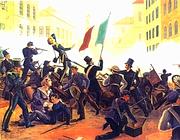
In 1848 Europe rebelled against absolutism. And Milan invented the first smoke-strike, which ended in blood.
LONDON – The idioms often have a historical background that justifies them: so today in Italian they say “success is a forty-eight” to indicate a sudden chaos, riot general of unexpected uproar. It is the same Mike Rapport, on the first page of his book 1848 The year of the Revolution, to recall the origin of this phrase: they were in fact the revolutionary events that weave their own in 1848 to crystallize the image mentioned, becoming the archetype – even verbal – of a confusing event but at the same time decisive. In that year, “a revolutionary storm struck Europe”: the new and disturbing feature was the timing of the episodes and the vastness of the areas concerned, two factors that according to the author would be reassessed only in part with the revolutionary wave triggered in 1989. The Five Days of Milan – Rapport’s book, therefore, deals with almost 600 pages in a moment of European history that was decisive for the fate of the various countries involved. By writing in a very pleasant and charming way, the author weaves the story of what happened in Paris and Milan, Naples and Budapest, Vienna and Venice, reconstructing the mosaic of the revolutions of ’48 and scoring the inextricable European link that was created among the local events. Three inspirations were common to all the revolutionary events of that year: the national inspiration, the constitutional one and the social one. The years of preparation for 1848 were those who saw the birth of a revolutionary person as a profession, who worked tirelessly to ensure that others achieved similar vocations: Rapport chooses the Genovese Giuseppe Mazzini as an example of enlightened thinker and influential protester, “such was the attraction exercised as a theorist and an apostle of revolution, Mazzini thought he could bring together the revolutionaries of all nations in a pan-European movement,” preparing his disciples to take the opportunity offered by the upheavals of 1848. In Italy, it happened that from the events of the ’48 constitution that would remain in force for almost one hundred years would be born: the Albertine Statute, in fact, promulgated in the Kingdom of Sardinia on March 4 by Carlo Alberto of Savoy, was then extended in 1861 and the new Kingdom of Italy, recalls Rapport, “ it remained formally in force until 1946.” But what was the origin of the Italian ’48, this revolution that produced the constitutional skeleton on which Italy based itself until after the fall of fascism? It was a birth far from epic, and it was, indeed, almost trivial. On 1 January 1848, in fact, in Milan it was staged that “which was perhaps the first concerted anti-smoking campaign in modern history”: the nobles and burghers of this city, which now had only the taxation of Austrian, decided to challenge the Vienna government through boycotts of tobacco. “ On New Year’s Day, the Milanese stopped smoking.” It sprang hours of tensions that led to January 3 in a massacre of civilians when, in fact, an Austrian soldier – guilty of smoking with ostentatious gestures – was shot in the face by a Milanese, a revolt that saw the Austrian garrison intervene violently against the crowd of people who rushed excitedly. There were, between them, six dead and fifty wounded, “the uprising of tobacco was so crushed, but a few weeks after Milan was the scene of the most famous” five days “, beginning the War of Independence.”
Book: M. Rapport, 1848. L’anno della Rivoluzione, traduzione di D. Scaffei, Laterza, Roma-Bari 2009 [ed. or. London 2008], pp. 579, € 24,00.
Source: http://www.corriere.it/unita-italia-150/10_dicembre_31/quarantotto-libro-salvatori_b5235e9e-14de-11e0-8d15-00144f02aabc.shtml